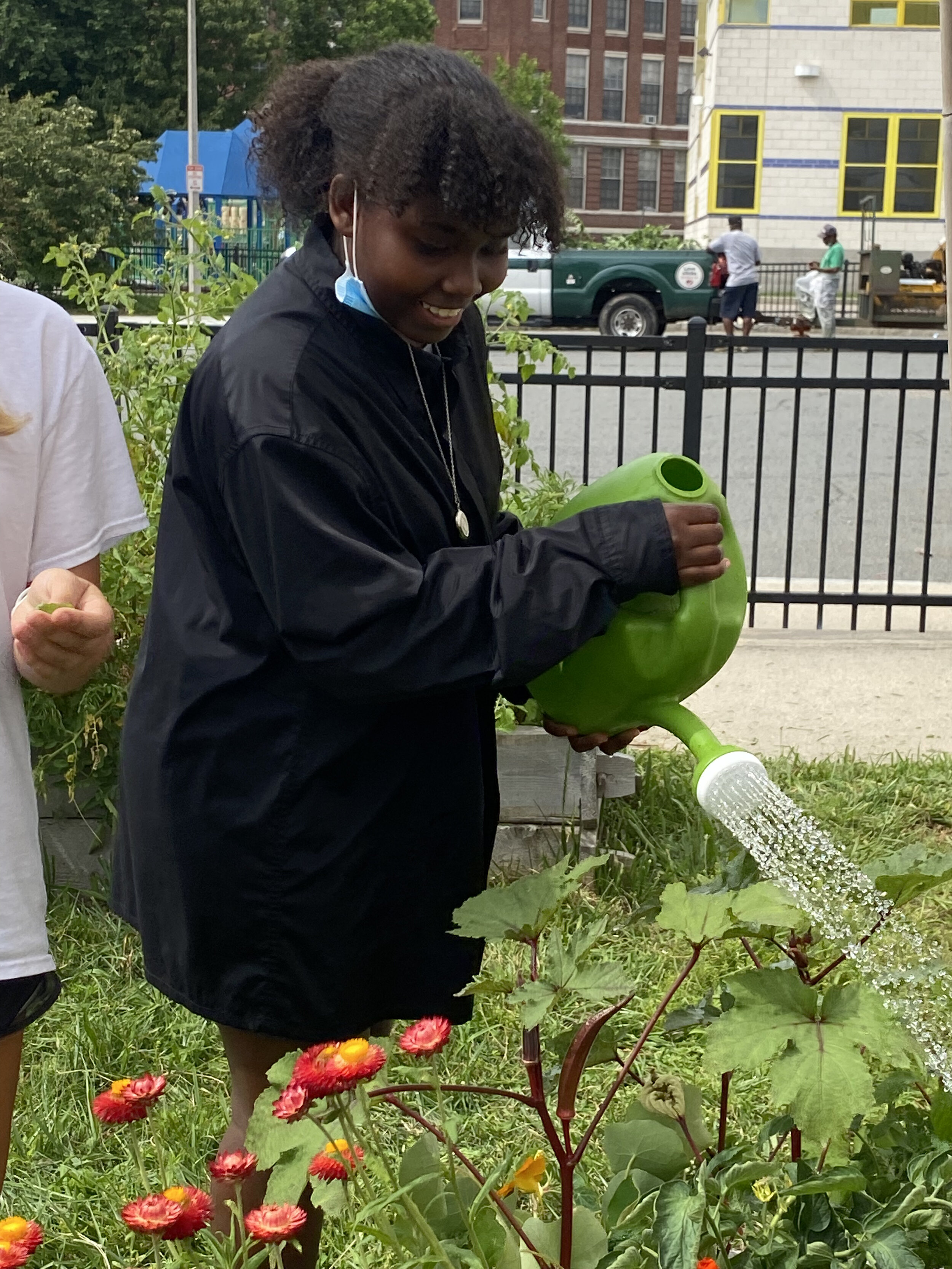Beyond the Garden: Connecting Science & Community to Conservation
It is not only amazing to look at the beautiful garden students have contributed to this summer, but how much they can tell you about the science behind maintaining a thriving garden in an urban environment and the powerful social and environmental effects gardening has on their community.
When I met with the Higginson-Lewis summer program site at Orchard Gardens (this group’s secondary garden that they help maintain each Wednesday), it was clear that, in only four short weeks, they were seasoned pros. As if on cue, the youth raced to the shed where they quickly got to work without any former instruction from Senior Garden Educator Karl or their Summer Fellows. Whether their contribution to the group effort consisted of watering each bed or harvesting their perfectly ripe zucchini or tomatoes, it was clear that teamwork was something they now understood to be a crucial component of running a successful community garden. “The nasturtiums in this bed act as an attractor for pollinators; if bees are drawn to the bed, they will be more likely to pollinate our vegetables and take care of pests too,” one youth explained to me as I surveyed their work. I asked a couple of youths whether they knew the nuances of how to correctly organize a garden before their time at CitySprouts. “No, I definitely did not know that gardens were so carefully planned out,” one youth replied. Another chimed in that, as a student at Orchard Gardens, they had always loved gardening when it was integrated into coursework during the school year and that they had spent time watering it outside of class hours. “Before, I had not had the chance to really contribute to a garden [on a consistent basis.] Now, I love gardening even more!” they told me with a smile when reflecting on finishing the Young Leaders Summer Program.
“Seeing and learning about the three sisters and how they were being used to surround the statue of a Native American man on a horse to give voice to the often overlooked women in those communities was a powerful experience.”
Once the students finished up their work and were ready to head back to Higginson-Lewis, I chatted with some other youth about their experiences outside of the garden during the program. “Visiting the MFA exhibit (Garden for Boston at the Museum of Fine Arts) was so cool because I discovered that plants could be used for more than a source of food,” answered a youth, “Seeing and learning about the three sisters (crops important to indigenous American culture: squash, corn, and beans) and how they were being used to surround the statue of a Native American man on a horse to give voice to the often overlooked women in those communities was a powerful experience.”
“I’ve learned that plants can grow in many different conditions and that there is a lot of engineering behind finding new ways to grow fruits and vegetables.”
Upon our return to Higginson-Lewis and a short snack break, students gave me a brief tour of their projects. “My hydroponic plant has been doing the best!” a youth gleamed as they held up their recycled 2-liter hydroponic system. “I’ve learned that plants can grow in many different conditions and that there is a lot of engineering behind finding new ways to grow fruits and vegetables.” Indeed, elongated sprouts dangled out of the top and anchored roots were visible through the bottle. Nutrient-infused water sitting at the bottom half of the bottle served as both a fertilizer and water source for the simple system. They also showed me their experiments on the effects of scarification on seedlings’ growth. Scarification is the process of breaking down or weakening the protective coating of a seed. “The more scarified a seedling is, the more likely it is to grow. We used sandpaper to roughen up these seeds and now they’re growing better,” they explained. With each new experiment explained to me by the youth, I learned something new about growth and gardening myself.
Finally, our day finished with the finalization of students’ solar ovens composed of recycled pizza boxes and aluminum foil. With these materials and the power of the sun, youth were attempting to utilize solar energy in order to roast a marshmallow. Although it was a cloudy day with temperatures in the mid-70s, youth scanned the temperature of varying materials around the garden and found a recycled plastics composite bannister with a sizzling 107° to rest their solar ovens on. One youth’s project resembled an actual oven, with walls on all four sides of the box surrounded by light-attracting black construction paper and aluminum foil, and seemed to get hot the fastest. After a lunch break of about 30 minutes, students enjoyed ooey-gooey marshmallows without the power of an oven, microwave, or fire. “I’m glad the program has science in it because I feel like I can learn more about gardening in detail, like about the effects of soil quality, pH levels, and finding new ways to grow plants,” one youth remarked upon the program. I have no doubt that these students are leaving their short time at CitySprouts as not only better gardeners, but skilled conservationists, scientists, and community leaders.




